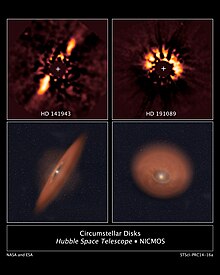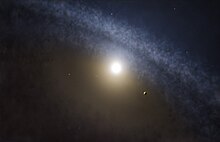Utilisateur:Eterneige/Brouillon
- → N'hésitez pas à publier sur le brouillon un texte inachevé et à le modifier autant que vous le souhaitez.
- → Pour enregistrer vos modifications au brouillon, il est nécessaire de cliquer sur le bouton bleu : « Publier les modifications ». Il n'y a pas d'enregistrement automatique.
Si votre but est de publier un nouvel article, votre brouillon doit respecter les points suivants :
- Respectez le droit d'auteur en créant un texte spécialement pour Wikipédia en français (pas de copier-coller venu d'ailleurs).
- Indiquez les éléments démontrant la notoriété du sujet (aide).
- Liez chaque fait présenté à une source de qualité (quelles sources – comment les insérer).
- Utilisez un ton neutre, qui ne soit ni orienté ni publicitaire (aide).
- Veillez également à structurer votre article, de manière à ce qu'il soit conforme aux autres pages de l'encyclopédie (structurer – mettre en page).
- → Si ces points sont respectés, pour transformer votre brouillon en article, utilisez le bouton « publier le brouillon » en haut à droite. Votre brouillon sera alors transféré dans l'espace encyclopédique.
Un disque circumstellaire est une accumulation de matière torique, annulaire ou
A circumstellar disc (or circumstellar disk) is a torus, pancake or ring-shaped accumulation of matter composed of gas, dust, planetesimals, asteroids or collision fragments in orbit around a star. Around the youngest stars, they are the reservoirs of material out of which planets may form. Around mature stars, they indicate that planetesimal formation has taken place and around white dwarfs, they indicate that planetary material survived the whole of stellar evolution. Such a disc can manifest itself in various ways.
Young star[modifier | modifier le code]

Erreur : La version française équivalente de {{Main}} est {{Article détaillé}}. According to the currently accepted model of star formation, sometimes referred to as the nebular hypothesis, a star is formed by the gravitational collapse of a pocket of matter within a giant molecular cloud. The infalling material possesses some amount of angular momentum, which results in the formation of a gaseous protoplanetary disc around the young, rotating star. The former is a rotating circumstellar disc of dense gas and dust that continues to feed the central star. It may contain a few percent of the mass of the central star, mainly in the form of gas which is itself mainly hydrogen. The accretion disc phase lasts a few to 10 million years. Accretion rates are typically 10−7 to 10−9 solar masses per year but can vary.
The disc gradually cools in what is known as the T Tauri star stage. Within this disc, the formation of small dust grains made of rocks and ices can occur, and these can coagulate into planetesimals. If the disc is sufficiently massive, the runaway accretions begin, resulting in the appearance of planetary embryos. The formation of planetary systems is thought to be a natural result of star formation. A sun-like star usually takes around 100 million years to form.
Circumstellar discs around the Solar System[modifier | modifier le code]

- Asteroid belt is a reservoir of small bodies in the Solar System located between the orbit of Mars and Jupiter. It is a source of interplanetary dust.
- Edgeworth-Kuiper belt, beyond the orbit of Neptune
- Scattered disc, beyond the orbit of Neptune
- Hills cloud; only the inner Oort cloud has a toroid-like shape. The outer Oort cloud is more spherical in shape, making it a circumstellar envelope.
Binary system[modifier | modifier le code]
- Circumprimary disc is where a disc orbits the primary (i.e. more massive) star of the binary star system[3]
- Circumsecondary disc is one around the secondary (i.e. less massive) star of the binary star system
- Circumbinary disc is where a disc orbits both the primary and the secondary of the binary system
Dust[modifier | modifier le code]
- Debris discs consist of planetesimals along with fine dust and small amounts of gas generated through their collisions and evaporation. The original gas and small dust particles have been dispersed or accumulated into planets.[4]
- Zodiacal cloud or interplanetary dust is the material in the Solar System created by collisions of asteroids and evaporation of comet seen to observers on Earth as a band of scattered light along the ecliptic before sunrise or after sunset.
- Exozodiacal dust is dust around another star than the Sun in a location analogous to that of the Zodiacal Light in the Solar System.
Disc evolution[modifier | modifier le code]
Circumstellar discs are not equilibrium objects, but instead are constantly evolving. The evolution of the surface density of the disc, which is the amount of mass per unit area so after the volume density at a particular location in the disc has been integrated over the vertical structure, is given by: where is the radial location in the disc and is the viscosity at location .[5] This equation assumes axisymmetric symmetry in the disc, but is compatible with any vertical disc structure.
Viscosity in the disc, whether molecular, turbulent or other, transports angular momentum outwards in the disc and most of the mass inwards, eventually accreting onto the central object.[5] The mass accretion onto the star in terms of the disc viscosity is expressed: where is the inner radius.
See also[modifier | modifier le code]
References[modifier | modifier le code]
- (en) « Circumstellar Disks HD 141943 and HD 191089 », ESA/Hubble images, {{Article}} : paramètre «
date» manquant (lire en ligne) - « ALMA Reveals Planetary Construction Sites » (consulté le )
- Discovery of a New Companion and Evidence of a Circumprimary Disk: Adaptive Optics Imaging of the Young Multiple System VW Chamaeleon, Brandeker, Alexis et al. 2001
- (en) Hubert Klahr et Brandner, Wolfgang, Planet Formation, Cambridge University Press, , 25 p. (ISBN 0-521-86015-6)
- Philip Armitage, « Dynamics of Protoplanetary Disks », Annual Review of Astronomy and Astrophysics, (DOI 10.1146/annurev-astro-081710-102521, Bibcode 2011ARA&A..49..195A, arXiv 1011.1496)
External links[modifier | modifier le code]
- Caer McCabe, « Catalog of Resolved Circumstellar Disks », NASA JPL, (consulté le )
- Image Gallery of Dust disks (from Paul Kalas, "Circumstellar Disk Learning Site)"


![{\displaystyle {\frac {\partial \Sigma }{\partial t}}={\frac {3}{r}}{\frac {\partial }{\partial r}}\left[r^{1/2}{\frac {\partial }{\partial r}}\nu \Sigma r^{1/2}\right]}](https://wikimedia.org/api/rest_v1/media/math/render/svg/eaa66a05e28b30af6b84c10b51751f2d4810afbd)



![{\displaystyle {\dot {M}}=3\pi \nu \Sigma \left[1-{\sqrt {\frac {r_{\text{in}}}{r}}}\right]^{-1}}](https://wikimedia.org/api/rest_v1/media/math/render/svg/63f486033a7d02b693a70591b528cff48bcc959b)

